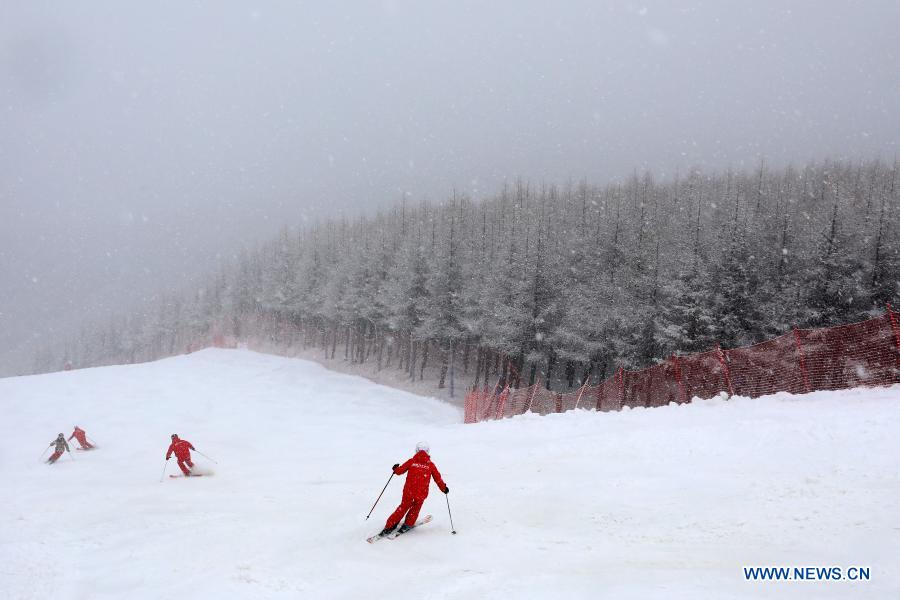(China Daily)10:49, November 27, 2020
Goldman Sachs, Morgan Stanley forecast nation to make quick economic rebound
Chinas economic growth is expected to recover strongly next year, driven by consumption, manufacturing investment and resilient exports, according to forecasts by leading international financial groups.
Projections for the GDP growth of the worlds second-largest economy in 2021 range from 7.5 to 9 percent, the fastest pace since at least 2015. This comes after the introduction of supportive policies, including monetary and fiscal measures, that were launched at the peak of the coronavirus outbreak in the nation.
The positive views on the prospects for Chinas economy come as policymakers in Beijing have drawn up the dual-circulation development paradigm with the domestic market being the mainstay and the domestic and international markets supporting each other.
The new development pattern is an active choice by China to better adapt to the changing and evolving development stage of the Chinese economy, and it is also a strategic move by China to respond to the complex and challenging international environment, Vice-Premier Liu He wrote in an article published in Peoples Daily on Wednesday.
Liu said that the dual-circulation model is crucial for China to raise its economic self-sufficiency and sustainability, boost the resilience of the economy and maintain stable and healthy growth.
Chinas timely and forward-looking policy adjustment has helped strengthen confidence in the worlds second-largest economy despite the COVID-19 pandemic posing serious challenges to the global economy and international industrial chains.
US investment bank Goldman Sachs predicted that Chinas GDP growth, on a yearly basis, is likely to rebound to 7.5 percent in 2021, up from a projection of 2 percent this year. The recovery will be mainly driven by household consumption and manufacturing investment. Its exports, in the meantime, are expected to remain resilient, it said.
Last week, another US-based investment bank, Morgan Stanley, offered an even positive forecast for Chinas 2021 GDP growth of 9 percent, led by a strong recovery in private consumption and global demand, with policy stimulus being phased out.
Chinas GDP growth is on track to reach pre-pandemic levels this year thanks to the countrys timely and efficient epidemic control measures, according to Madhavi Bokil, Moodys vice-president and senior credit officer.
The significant fiscal and monetary policy support that is already in place will facilitate a pickup in economic activity after new COVID-19 restrictions are lifted, Bokil said.
The country is shifting to the dual-circulation development paradigm, which seeks to steer its economy toward domestic demand drivers, but never to give up external markets.
Given an expectation that China will further integrate into the global economy, China will be a part of the main driver of the worlds growth next year, especially for G20 emerging market countries. Its recovery has already benefited export growth in other countries, such as Germany, Bokil said.
While the Chinese economy is expected to be on a stable path of recovery, economists expect that Chinas monetary and fiscal policies are likely to gradually normalize.
The view was backed by the recent rise of the interbank markets seven-day repo rate, a gauge of the prices of loans borrowed between commercial banks, which has mostly returned to pre-COVID levels. Credit growth has also slowed from the peak in the March-to-May period.
In China, monetary and credit policies have already been normalizing, Shan Hui, chief China economist at Goldman Sachs, told China Daily.
Looking into the near future, Shan said that Chinas policy rates are likely to remain stable, while credit growth may decelerate further.
In terms of fiscal policy, the Goldman Sachs economist predicted the governments on-budget fiscal deficit would narrow from 3.6 percent of GDP this year to 3 percent in 2021, although local governments maturing bonds and refinancing demand are likely to pick up next year.
Robin Xing, chief China economist at Morgan Stanley, said that private consumption could emerge as the key growth driver in the coming months, with a release of excess savings of Chinese residents and the overall recovery of the domestic job market.
Stronger global demand and reduced risks of trade tensions would boost manufacturing investment, outweighing slower construction activity and a slightly narrowed surplus of trade in goods and services, according to Xing.
Policymakers will likely normalize credit growth and the fiscal stance in 2021 with a full recovery in the labor market and the deployment of COVID-19 vaccines in major economies, he added.
Economists also predicted that the normalization of Chinas monetary and fiscal policies will further elevate the interest rate differential between China and the United States, which will be one of the drivers of a further appreciation of the renminbi and stronger foreign exchange inflows into China next year.
But other major economies are likely to maintain monetary easing and fiscal stimulus to tackle the COVID-19 shocks. And the US and European Union central banks may re-raise their policy rates as early as 2025, Goldman Sachs economists said.
![]()

